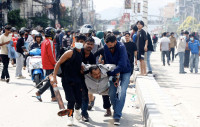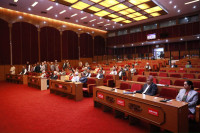Columns
Battered roads and chaotic traffic
Pedestrians, public transportation, government vehicles, goods carriers and private vehicles, in that order, should get priority..jpg&w=900&height=601)
Shyam Sunder Kawan
If Kathmandu's roads had life, they would feel the agony of being treated brutally. Whenever a mishap occurs, roads are the first to be blamed for not being in proper shape. As a road user, whether a pedestrian, biker or motorist, you definitely would curse the road first if anything wrong happens. We seldom feel how the roads have fared till now. Every day, you’ll see hundreds of thousands of vehicles rolling over them hastily. The roads are covered with dust on dry days and slush on wet days. So it’s high time to think whether it’s because of the roads that undesirable incidents happen or it's because of the way we utilise them. It’s not the beauty and services that portray the image of a city, but also the users who add value to them. Roads are the venue for numerous activities of public domain, and so their condition undoubtedly impacts urban life.
Most roads lack drainage, footpaths, greenery, lighting and street furniture. Because of these shortcomings, there is a high risk of potential conflicts between vehicles and pedestrians. During construction, no thought is given to the edges and other accessories of road infrastructure—the only thing that is considered is the blacktopping of the carriageway. We have not yet been able to think of other public amenities to provide comfort to the ordinary citizens who use the roads.
The end-of-the-year rush is most visible in road construction projects. In a bid to finish the allocated budget, roads are built over mud and puddles are filled with coal tar. Then builders of other infrastructure like sanitation, water supply, electricity and telecommunications move in and dig up the roads in their own end-of-the-year rush. An integrated and coordinated way to involve all these line agencies and respective departments at the time of construction has never happened in Nepal.
Following the declaration of a federal system, roads are being built haphazardly all over the country. Despite the set vision and objectives, the construction of roads is being done in haste without any thought about the objectives. As a result, roads that are under construction remain incomplete everywhere, causing difficulty in the daily lives of the people. Most importantly, the extensive road building campaign has proved to be senseless to the natural environment. Agricultural lands, beautiful hills and green forests have been destroyed in the name of providing accessibility to a few individual habitations, resulting in constant landslides during monsoon.
If we look closely at the traffic gridlock in the Kathmandu Valley, we see the blatant abuse of traffic rules. Hundreds of vehicles are bunched up at traffic junctions waiting for the green light. If they keep to their own lanes and form a single line, they could easily move forward when the light changes, or when the police personnel gives the signal. Instead, they create unnecessary traffic congestion. Do we really need police officers standing at every street corner to direct traffic like a shepherd guiding sheep? It seems all drivers have lost their minds, the way they do not even stop for pedestrians at zebra crossings.
Pedestrians, public transportation, government vehicles, goods carriers and private vehicles, in that order, should get priority on every street. This will enable authorities to maintain the road infrastructure properly.
Looking at the way roads are being maintained in Nepal, you will never be able to convince yourself that they are good enough to travel on. Dust gets swept and heaped on the side of the road, and it is never collected. Craters are filled with gravel, but they never get compacted and covered with a layer of asphalt. As soon as they finish maintenance in one place, another crater appears in another place. This has been a continual occurrence.
Visibility is very bad on the roads. Our roads are covered with dust during the entire dry season. In many cases, the top layer of asphalt has already worn out due to excessive vehicle mobility or bad workmanship. Motor vehicles entering urban areas from the rural sector also carry dust and deposit it on the roads. The authorities have a responsibility to conduct regular maintenance of these roads and streets. Once, all three municipalities in the Kathmandu Valley had demanded broomer machines to clean their respective roads and highways. But it seems that they are idle, since the roads remain dirty and dusty.
***
What do you think?
Dear reader, we’d like to hear from you. We regularly publish letters to the editor on contemporary issues or direct responses to something the Post has recently published. Please send your letters to [email protected] with "Letter to the Editor" in the subject line. Please include your name, location, and a contact address so one of our editors can reach out to you.




 9.12°C Kathmandu
9.12°C Kathmandu















